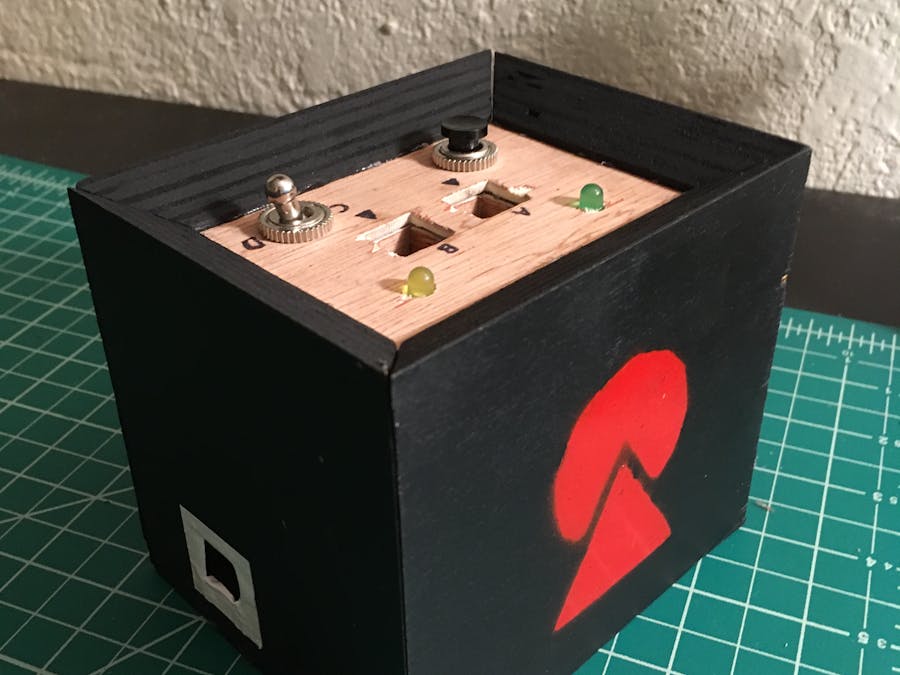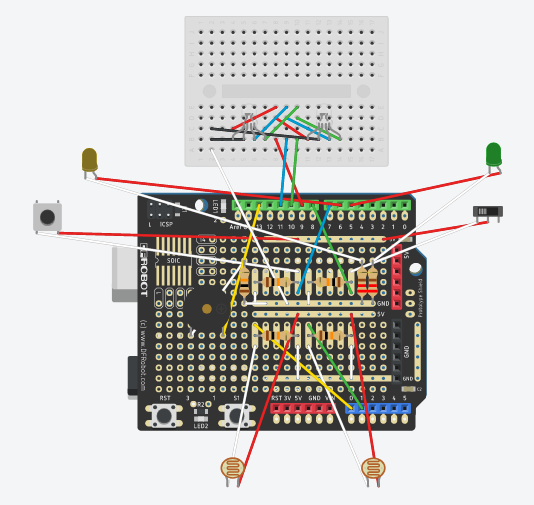int buttonVal, toggleVal, cal = 0;
int sample = 1;
int buzzer = 13;
int toggle = 8; int button = 7;
int redPin = 9; int greenPin = 10; int bluePin = 11; //RGB Led
int goodPin = 5; int statusPin = 6;
int sensorPinOne = A0; //LDR
int sensorPinTwo = A1;
int cellOne[2][41]; int cellTwo[2][41];
double wavelengths[41] = {380, 390, 400, 410, 420, 430, 440, 450,
460, 470, 480, 490, 500, 510, 520, 530,
540, 550, 560, 570, 580, 590, 600, 610,
620, 630, 640, 650, 660, 670, 680, 690,
700, 710, 720, 730, 740, 750, 760, 770, 780};
double colors[41][3] =
{ {97, 0, 97}, {121, 0, 141}, {131, 0, 181}, {126, 0, 219}, {106, 0, 255}, {61, 0, 255}, {0, 0, 255}, {0, 70, 255},
{0, 123, 255}, {0, 169, 255}, {0, 213, 255}, {0, 255, 255}, {0, 255, 146}, {0, 255, 0}, {54, 255, 0}, {94, 255, 0},
{129, 255, 0}, {163, 255, 0}, {195, 255, 0}, {218, 255, 0}, {255, 255, 0}, {255, 223, 0}, {255, 190, 0}, {255, 155, 0},
{255, 119, 0}, {255, 79, 0}, {255, 33, 0}, {255, 0, 0}, {232, 0, 0}, {210, 0, 0}, {188, 0, 0}, {165, 0, 0},
{143, 0, 0}, {237, 0, 0}, {219, 0, 0}, {200, 0, 0}, {181, 0, 0}, {161, 0, 0}, {141, 0, 0}, {119, 0, 0}, {97, 0, 0} };
float transmittance[2]; float absorbance[2];
unsigned long previousMillis = 0; const long statusInterval = 300; //Debouncing
void setup() {
Serial.begin(9600);
pinMode(buzzer, OUTPUT);
pinMode(toggle, INPUT); pinMode(button, INPUT);
pinMode(redPin, OUTPUT); pinMode(greenPin, OUTPUT); pinMode(bluePin, OUTPUT);
pinMode(goodPin, OUTPUT); pinMode(statusPin, OUTPUT);
pinMode(sensorPinOne, INPUT); pinMode(sensorPinTwo, INPUT);
Serial.println("--- MiniSpec ---"); Serial.println();
tone(buzzer, 400, 150);
}
void loop() {
toggleVal = digitalRead(toggle);
analogWrite(goodPin, HIGH); analogWrite(statusPin, LOW);
setColor(0, 0, 0);
if (toggleVal == 0) {
if (digitalRead(button) == 1) {
stabalize();
analogWrite(goodPin, LOW);
for (int x=0; x<41; x++) {
analogWrite(statusPin, HIGH);
setColor(colors[x][0], colors[x][1], colors[x][2]); delay(333);
cellOne[0][x] = analogRead(sensorPinOne); cellTwo[0][x] = analogRead(sensorPinTwo); delay(10);
}
Serial.println("Calibration Complete"); Serial.println();
cal++;
}
}
if (toggleVal == 1) {
if (digitalRead(button) == 1 && cal >= 1) {
stabalize();
analogWrite(goodPin, LOW);
for (int x=0; x<41; x++) {
analogWrite(statusPin, HIGH);
setColor(colors[x][0], colors[x][1], colors[x][2]); delay(333);
cellOne[1][x] = analogRead(sensorPinOne); cellTwo[1][x] = analogRead(sensorPinTwo); delay(10);
}
setColor(0,0,0);
analysis();
} else if (digitalRead(button) == 1 && cal == 0) {tone(buzzer, 100, 200);}
}
}
void stabalize(void) {
setColor(255,255,255);
for (int y=0; y<5; y++) {
analogWrite(goodPin, LOW); delay(300);
analogWrite(goodPin, HIGH); delay(300);
}
}
void setColor(double red, double green, double blue) {
analogWrite(redPin, (int)red);
analogWrite(greenPin, (int)green);
analogWrite(bluePin, (int)blue);
}
void analysis(void) {
Serial.println(); Serial.print("Sample "); Serial.println(sample); Serial.println();
previousMillis = millis();
for (int x=0; x<41; x++) {
transmittance[0] = (float)cellOne[1][x]/(float)cellOne[0][x];
transmittance[1] = (float)cellTwo[1][x]/(float)cellTwo[0][x];
absorbance[0] = log10(1/transmittance[0]);
absorbance[1] = log10(1/transmittance[1]);
float avgAbsorbance = ((absorbance[0] + absorbance[1])/(float)2);
Serial.println(avgAbsorbance);
delay(100);
if (millis() - previousMillis >= statusInterval) {
analogWrite(statusPin, LOW);
}
if (millis() - previousMillis >= statusInterval*2) {
analogWrite(statusPin, HIGH);
previousMillis = millis();
}
}
sample++;
}




_ztBMuBhMHo.jpg?auto=compress%2Cformat&w=48&h=48&fit=fill&bg=ffffff)













Comments